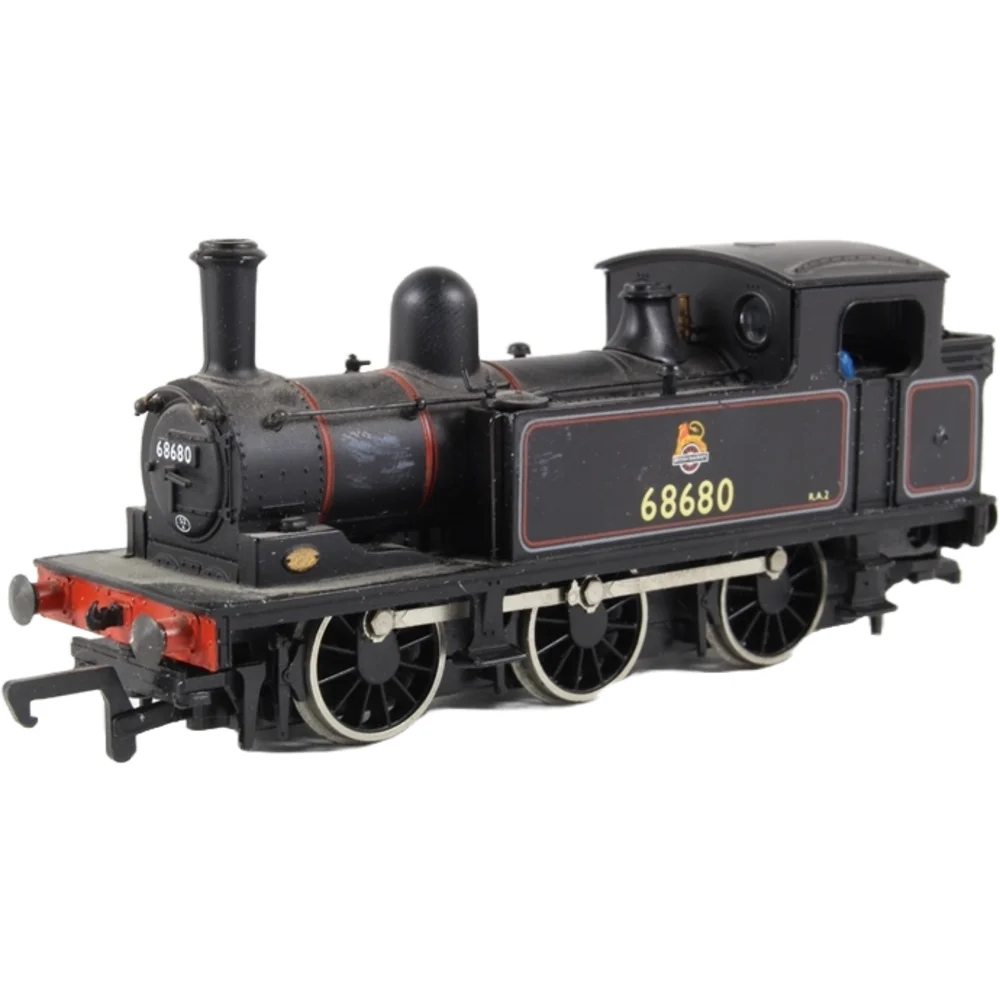Bachmann 31-052
London & North Eastern Railway J72 68680 British Railways Lined Black with Early Emblem
Tooling
The LNER Class J72 (originally NER Class E1) was a small 0-6-0T shunting locomotive designed by Wilson Worsdell and built between 1898 and 1951. Its longevity and simplicity made it a popular subject for ready-to-run models. The first OO gauge J72 appeared in 1976 under the Mainline Railways brand, and when Bachmann entered the UK market in the early 1990s, they adopted this tooling for their Branchline range. This tooling remained in production until 2008, when a completely new model was introduced.
Tooling Features
- Scale: OO gauge (1:76).
- Construction: Plastic body shell with die-cast split chassis frame.
- Detailing: Considered advanced for its time, featuring separately fitted wire handrails and fine livery application.
- Couplings: Standard tension-lock couplers mounted on the chassis.
Mechanical & Electrical
- Motor & Drive: Powered by a pancake motor mounted in the split chassis, driving all three axles.
- Minimum Radius: Suitable for standard OO curves (approx. 2nd radius).
- Lighting: None fitted.
- Weighting: Moderate weight from die-cast chassis, aiding traction for shunting duties.
DCC Capability
The original tooling was not DCC ready. Conversion required significant modification or replacement chassis kits. Later Bachmann retooling (post-2008) introduced 8-pin and later 18-pin DCC sockets, but these were absent from the 1990-era models.
Liveries Produced
Across its production life, the ex-Mainline tooling appeared in a wide range of authentic schemes, including:
- NER green
- LNER lined black
- LNER plain black
- BR black (early and late crests)
- BR lined black and green (specials)
These liveries reflected the prototype’s long service life under NER, LNER, and BR.
Performance & Reviews
While praised for its appearance and detailing, the model’s performance was often criticized. The split chassis design avoided wiper pickups but introduced reliability issues, and the pancake motor limited smooth running. Wheel quartering problems were common in early examples, though later friction-fit wheels improved matters slightly.
Media & Community Commentary
Enthusiasts frequently note the J72’s historical significance as one of the first highly detailed RTR tank engines in OO gauge. Social media and forums often describe the model as “charming but dated,” with many recommending chassis replacement kits for improved running. The tooling is fondly remembered for its role in raising detailing standards in the 1970s and 1980s.
Interesting Facts
- The prototype J72 class was built over an extraordinary 53-year span, making it unique among British steam designs.
- The Bachmann model retained the Mainline body tooling almost unchanged for nearly two decades before retooling in 2008.
Class & Prototype
- Class: London & North Eastern Railway J72
- Traction: Steam
- Built: 1898-1951
- Total Built: 113
- Running Number: 68680
- Ordered By: North Eastern Railway
- Built By: North Eastern Railway
- Built At: Darlington
- Built: 03/1899
- Withdrawn: 10/1961
- Length of Service: 62.6 years
- Running Numbers: NER 1720, LNER 8680, BR 68680
- Names: -
Operator & Livery
- Operator: British Railways
- Livery: Lined Black with Early Emblem
- Era: 4 - British Railways Early Emblem
British Railways transformed Britain's fragmented rail network into a unified national system following nationalisation on 1st January 1948. Created from the "Big Four" companies under the Transport Act 1947, BR operated most of Great Britain's railways until rebranding as British Rail in 1965, managing over 20,000 route miles and inheriting nearly 20,000 locomotives of diverse designs.
The organisation pioneered standardisation through its revolutionary BR Standard locomotive programme (1951-1960), producing 999 advanced steam engines under Robert Riddles' direction. These included the versatile Britannia Pacifics, mighty 9F freight engines, and mixed-traffic classes that incorporated the best features from all predecessor companies. The 1955 Modernisation Plan accelerated diesel and electric traction development, creating fascinating mixed-traction operations.
Notable achievements included establishing unified locomotive classification systems, introducing distinctive corporate liveries, and managing the complex transition from steam to modern traction. BR's six regional structure preserved operational diversity whilst enabling standardisation of practices, signalling, and rolling stock that had eluded private enterprise for over a century.
The BR era represents steam traction's final flowering alongside emerging diesel technology, creating unparalleled locomotive variety. Today, this heritage remains highly popular with railway enthusiasts through extensive preserved fleets, heritage railway operations, and comprehensive model ranges from manufacturers like Hornby, Bachmann, and Dapol, making BR subjects essential for authentic post-war British railway modelling across all scales.
British Railways' lined black livery was designated for mixed-traffic and secondary passenger locomotives from 1949, following pure LNWR style with black base colour and elaborate red, cream (off-white), and grey lining patterns. The lining specification comprised 5/8" grey, 1/8" cream, 1½" black, and ¼" red bands, with the layout consistent with LNWR practice including deep and shallow valances lined along bottom edges only, unlike green engines. The first lined black engines appeared in August 1948 when Hall 5954 appeared so painted, becoming one of the first to carry the "Lion and Wheel" emblem around the same time.
A wide range of engines was eligible for this livery, from powerful V2s and Counties down to tiny Southern Terriers, encompassing County, Hall, Grange, Manor, Saint, Prairie tanks, and numerous pre-grouping designs of varied shapes and sizes. This created many variations and interpretation problems due to the diverse locomotive types involved, with regional differences in splasher lining treatment—the Eastern Region used red-only splasher lining, whilst the Southern Region evolved from inset to edge lining styles. The emblem was positioned centrally on tender sides above the middle axle box, with the Western Region favouring larger sizes on tenders and bigger tank engines. An interesting period detail saw number plates routinely painted red from late 1949 to early 1952, adding colour contrast to the otherwise black scheme. This livery represented BR's commitment to standardising mixed-traffic operations whilst maintaining the decorative traditions that distinguished passenger-rated locomotives from plain freight engines.
